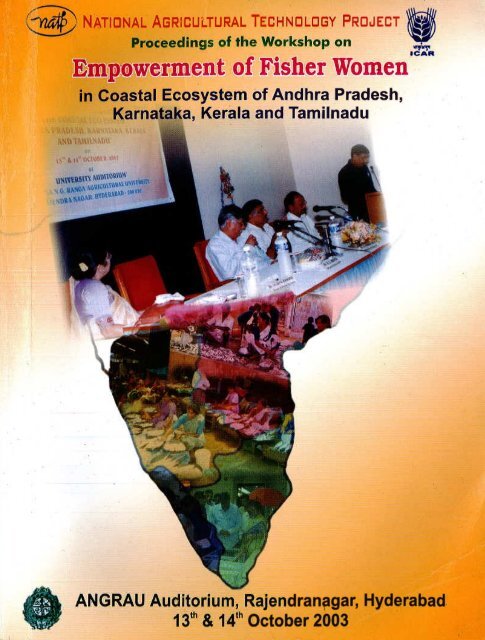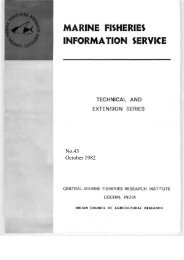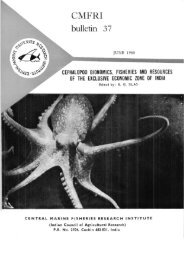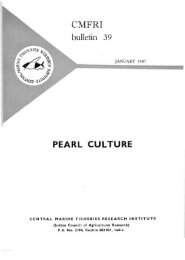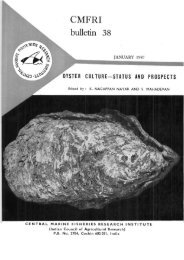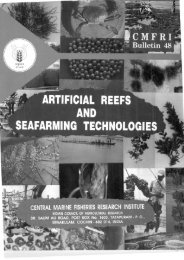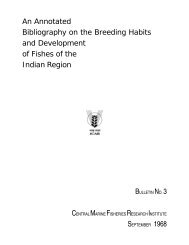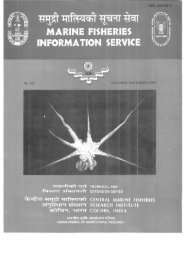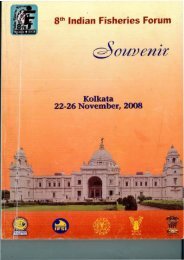PDF - Eprints@CMFRI
PDF - Eprints@CMFRI
PDF - Eprints@CMFRI
Create successful ePaper yourself
Turn your PDF publications into a flip-book with our unique Google optimized e-Paper software.
Chapter 2BENCH MARK SURVEY OF SELECTED VILLAGESABSTRACTH.Mohamad Kasim', Vijaya Khader**, R.Sathiadhas*, R.Narayana Kumar*,J. Lakshmi**, K. Dhanapal**, N.S. Sudhakara*** and Femeena*The research project "Studies on fisherwomen in t.he Qoasta.1 Ecosystems of Andhra Pradesh,Karnataka, Kerala and Tamilnadu" "'as carried out wltl1 an aim to S udy (he socio-economio, nutritionaland health status of the fisherwomen besides imparting them raining, in alternate income generatingactivities to improve their standard of living. To facilitate the conduct of this project a benchmark SUlVeywas condl~cte d and the basic information on different aspeots of th e fisherwomen and general eatufl~Ssuch as physical and geographical. demographical and other related Information were collected. TheInfonnation tnus collected reveal that the Andhra pradesh lies' on the ess coast, Karnataka and Keralafies on the wesl coast while Ta.mnnadu covers both east and west eOElst Total oocistal lenQth of the studyarea is 2940 km and the landing centers were 1243. Out of 34 co~stal Dfslricts in thes·e four stales,present study was conducted in 13 d1 stricts covering 27 villages ~"d5 744 no'useho Ids. The totalflsherpopu lation of the study area is 33,65,452. with an ac lve fisher folk population Of 8,45,354. There are atotal 661 ice pia nts, 118 free:z ing plan t.s, 214 processing plants. 594 peeling sheds and 106 olher un itsmainly cold storage and net maklng u.nits. There are 28,169 mechanized raft$. 35,938 motorized unitsand 1,23,877 traditional crafts in operation In the entire s udy area, ,As much as 9;-98,596 ha of potentialarea are available for aquaculture and a totai production ot 4,7G,94S-tones is record~d . The averagefamily slze Is 4.5 and the most domtnant age group .is youth, aged between 7 and 25 years. Literacy rateIs 65.6% and 54.7% of women in the study area are involved In fishery related sotlvities, Mosl of thefishing fam'lIes belongs to back ward community practicing HindUism. MajoriW of them live in own houseand the ype prevalent is tiled house. Most of -them are, land less and consequently eto not participate naquaclJ Itura actiVi es. Nearly 60,5% of fisherwomen earn between Rs, 1000 and 2000 per monthIndicating a very low income eaming and are poor. Many of them are not members in wome n self helpgroups.INTRODUCTIONThe basic fundamental requ rement is the detailed information. an the resource potentials,1nfrasll'tlc ure availab! ity and prevailing status of developmentalactlvities under progress In theecosystem for harnessing an eca-friendly sustainable development In any ecosystem underconsideration. This can be obtained through a proper bench ma",k sUlVey of the eCQsystem. The "BenchMark Survey" refers to the survey of he area \lhere we want to oonduct a research Pl"9ject. or implemenscheme before the commencement of the work to DOliect some basIc infolJ11atlon against which theImpact of the project can be evaluated.A Research Project entitled, "Studies on fisherwomen In the Coastal Ecosystems of AndhraPradesh, Karnataka. Kerala and Tamilnadt.j" was proposed by the A:N,Q Rang~ Aijricullural UniversIty incoilaborat/o'" wi h Central Marine Fisheries Research Instltute and University of Agricultura! Sciences,Mangalore under the 'Nationa,1 Agri.cultural TechnQlogy Project (NA : P) 1uf'\Qed by World Bank, heproject aimed 0 study the socio-economic, nutritional and health sta!us. of the fisherwomen besidesImparting them tra1ning in alternate Income generating activities to Improve their standard of riving. Withth~s theme il'l focus, in these four states 27 coastal villages spread across 13 districts were selected forthe study, To ·facilitate the conduct of this project a benchmark surVey was conducted 1n these vii/ages tocollect the basic information about different aspects of the fisherwomen and general features of theselected r·egions (Physical and Geographical, Demographical and related information). The information• 'ermal Marine ' Ishori~ Research lnsllttlt Kochi -682 014** Acharya N.G.Ranga Agricultural University, Hyderabad - S!>O 030*** College of Fisheries, Mangalore - 575002
thus collected are presented in this paper in two parts-Part I dealing with the macro level data pertaininto fishery and fishery related aspects and Part II summarizing the salient features of the selected village;which supported tile selection of these viltages for this study.MethodologyThe required information was collected from two sources namely primary and secondary. Thesecondary sources included the publications of the State Government Departments of the respectivestates, statistical yearbooks published by the Directorate of Economics and Statistics of the concernedState Governments, the Annual Reports of the respective State Fisheries Departments and otherpublished information from the gazettes and journals. The information was collected with the help of aplanned schedule and compiled in Part I. The primary data was collected with the help of thequestionnaire prepared after. during the discussion in the first meeting of the Research Project Team. APreliminary Survey was conducted in about 1000 households in each State covering different groups offisherwomen. It was proposed to give coverage for all the three groups of fishery sector namely,mechanized, motorized and non-mechanised sectors. The salient features of the preliminary survey arepresented in Part II.Statistical analysisThe date genera:ted has been utilized to meet the objectives of the study, Frequency distributions, Meanand Standard Deviations and tests of significa nce were utilized and the results are provided for each ofthe variables studied. Analysis variance, Chisquare test and multiple comparision ' t' test procedureswere utilized and the results are been provided in the chapters (Visveswara Rao, 1996)Results and DiscussionThe analysis of the information collected from the primary and secondary sources have beendone in two parts as mentioned below.3.1 Geographical LocationPART IGeneral Details of the Study Area -Macro Level InformationThe survey was carried out in four maritime states of India Andhra Pradesh, Karnataka, Keralaand Tamilnadu and the general details of the study area such as the geographic locations, boundaries ofthese states and other details re give n here under. The details of the geographiGal ~ocat i o fl of the S tqte~are presented in Table 1. The geographic locations of the four maritime states are summarized in thefollowing table. This shows that these states are located in a tropical belt with prolonged sunshine andbestowed with two monsoons.Table 1 Geographical Location of the Selected StatesDetails Andhra Pradesh Karnataka Kerala TamilnaduLatitude 12° 141 - 12° 50 1 - 8° 18 1 - 8°5 1 -19° 54 1 N 14° 48 1 N 12° 48 1 N 13 0 35 1 NLongitude 76° 50 1 - 74°5 1 - 74°5i - 76° 15 1 ....,84°50 1 E 74°8 1 E 77°221 E 80°20 1 E11
3.2 Boundaries of the StatesThe data regardng the boundaries of the study area are presented ' 0Table 2: Boundaries of the study areasDirections Andhra pradesh Karnataka Kerala TamilnaduNorthSouthEastWestChattisgarh & Maharashtra &Andhra pradesh &KarnatakaOrissa Andhra pradesh KarnatakaTamilnadu & Kerala &Gulf of Mannar &TamilnaduKarnataka Tamilnadu Indian OceanBay of BengalKarnataka &Mah~rahtraAndhrapradesh &TamilnaduTamilnadu &KarnatakaBay of Bengal, PalkBay & Gulf ofMannarArabian Sea Arabian Sea Kerala & Arabian seaIt can be summarized from Table 2 that, the whole study area is surrounded by sea on threesides ie, south by Indian ocean, west by Arabian sea and east by Bay of Bengal. and north is covered byChattisgarh, Orissa and Maharastra. Among the States, Andhra Pradesh lies in the east coast, Tamilnadu'covers both east and west coast, Kerala and Karnataka lies in the west coast.3.3 Fishery resources of the Selected StatesThe fishery resources of the States Include the leng,th of the coastal line, coastal districts,fishermen population (total and active), crafts and gears operated, fishery resources like the species offish that are harvested, fishery infrastructure and the area under aquaculture (brackish and fresh water),These information have been discussed below.3.3.1 Details of Coastal length and Coastal districtsThe details of the coastal length and the number of coastal districts in the selectedStates are presented in table 3.Table 3: Coastal length, number of landing centers, total Districts and coastal Districts in theselected States.Particulars Andhra Karnataka Kerala Tamilnadu TotalCoastal Length (Kms) 974 300 590 1076 2940Landing centres (No) 508 34 333 368 1243Total Districts (No) 23 27 14 29 93Coastal Districts (No) 9 3 9 13 34% of Coastal districts 39.1 11.1 64.3 44.S 36.5Note: Percentage of coastal districts are different between states (P
out of the four states covered under the present srudy Kerala has more percentage ;t eoastaJ d;stri~s ie,64.3, followed by Tamflnadu {44.S%), Andhra (39.1 %) and Karnataka (11 .1 %),3.3.2 DemographyTIle da regarding he fjshermen population both total and active are presented in table 4.Tab I 4: Fishermen population in the selected StatesDetails Andhra Pradesh Karnataka Kerala Tamilnadu Tota'Total Fishermen pop. 871709 764032 1050000 679711 3365452Active Fishermen pop. 204417 204347 164148 272442 845354Active Fishermen (%) 23.4 26.7 15.6 40.1 25.1Note: Vanations in active fishermen (%) are significant between states (P < 0.01)It is seen from the table, that the total fishermen populatlon of tbe selected states is 33,6-5,452, out ofwhich, the active fishermen opula ion Is only 8,45,354 Ie, 25.1 per cen!. Among the selected States,Tamilnadu has the hlghes t. active Ishermen population (40,1%) followed by Kamataka (26,7%). Andhra(23.4%) and Kerala .(15.6%). The differences are found significant (P
3.3.4 Fishery resources of the Selected StatesThe Importanl fishery resources of the Selected States are presented below in table 6.Table 6: Important Fishery reso~rces of the selected statesAndhrapradesh Karnataka Kerala TamilnaduSardines Sardines Sardines SardinesPenaeidprawns Mackeral "Mackeral Penaeid prawnsNon-penaeid prawns Seerfish Seerfish SilverbelliesRibbon fish Ribbon fish Ribbon fish AnchoviesCat fishes Sciaenids Sciaenids Ribbon fishPomfrets Carangids Elasmobranches ElasmobranchsMackerals Catfish Pomfrets PomfretsSharks Panaeid prawns Panaeid prawns MackeralsCarangids Pomfrets Anchovies PerchesSciaenids Carangids Other clupeidsThe fishery resource potentials differ from coast to coast and from state to state. The fisheryresouroes of the east coast are different from the west coast. However, the dominant resource appears tobe Ihe sardines, which includes the oil sardine and the lesser sardines followed by the Indian mackerel.The penaeid prawns occur in all the state with variation in the quanti y. Whereas the non-penaeidprawns are dominant only in Andhra Pradesh. The perches are characteristics to Tamilnadu coast andthe elasmobranches occur more on the south east and south west coasts. Silver bellies are dominantalong the Tamilnadu coast.3.3.5 Fishery infrastructureThe fishery infrastructure is important from the post harvest point of view in the fishery sector. Awell-developed fishery infrastructures indicate a well established processing industry in the State. Thedetails of the fishery infrastructures in the selected States are presented in table 7.Table 7: Fishery. Infrastructure of the selected StatesDetails Andhra Pradesh ('Yo) Karnataka('Yo) Kerala (%) Tamilmidu ('Yo) Total ('Yo).Ice plants 355 (68.1) 151 (53.5) 140 (16.3) 15(50.0) 661 (39.0)Net making units 0(0.0) 3 (1.1) 4 (0.5) 7 (0.4)Freezing plants 38 (7.3) 22 (7.8) 53 (6.2) 5 (16.7) 118 (7.0)!pj:Qcessing plants 36 (6.9) 25 (8.9) 143 (16.6) 10 (33.3) 214 (12.6)Peeling sheds 48 (9.2) 26 (9.2) 520 (60.4) 594 (35.1)Others 44(8.5) 55 (19.5) 0(0.0) 0(0.0) 99 (5.9)Total 521 (100.0) 282 (100.0) 660 (100.0) 30 (100.0) 1693 (100.0)Note: Figures In parenthesIs are percentagesThe details on the fishery infrastructure facilities available in these states ~Qte that out of the total1693 units, there are 661 Ice plants, 7 net making units, 118 freezing plants, 214 processing plants, 594peeling sheds and 99 other fishery infrastructure units mainly cold storage in these four states. Statewisedetails indicate that more number of units are available in Kerala followed by Andhra Pradesh, Karnatakaand Tamilnadu. fhe poor number of fishery lnfrastructure facilities available in TamUnadu when comparedto its marine fish productlon may be owing to the best fransport facilities avallab'le.3.4 Aquaculture potential of the Selected StatesWith the capture fishery reaching a peak and remaining stagnated, a viable alternative was seen inaquaculture. The attention is now baing given for utitizi 9 the area under aquaculture and bringing morearea under culture of different speCies. to nleet tne export dem.>.:lnd as well as the domestic demand. The
details of the potential area under aquaculture and the production in the selected States are presented intable 8. .Table 8: Potential area under aquaculture in the selected statesDetails Andhra Pradesh Karnataka Kerala Tamilnadu TotalArea under culture (hect) 62593 500000 65213 370790 998596Total production (tones) 44856 264000 54000 114089 476945Rate of production/ha (t) 0.72 0.53 0.83 0.31 0.48Total area of 9,98,596 hectare is potentially avaIlable for aquaculture and a total production of4,76,945 tones ;s recorded In the study area. Kamataka has the maximum potential area, and recordedthe maximum production among the four states 0 the study area. The rate of produotion roughly workedout for these four stafes indicates that Kerals ra nks (5t followed by Andhra Pradesh, Kamataka andTamj[nadu. The over all production rate is. only OA8 t P r ha whic is very low and there IS brightprospects for fish production through aquacullure in these states throug'h approprialte eco-friendlymethods.PART IIDetails of the Villages Selected for the StudyIn this section, the details regarding the selection of the sample districts, villages and householdsc;re discussed. Besides the results of the preliminary survey conducted is also described.4.1 Selection of districts and villagesThe selection of districts for each State was decided during the first interaction meeting of theresearch project Team. It was decided to have four districts in A.P, two in Karnataka, three in Kerala andfour in TamilnaduThe 'districts were selected based on their relative importance with respect to fishing in therespective States. From the selected districts, the villages were selected, again based on theirimportance in fishing and giving representation to all the three sectors of fishery namely-Mechanised,Motorised and Non-mechanised. For ,example in North Tamilnadu, Pudmanaikuppam In Chennai is apredominantly a mechnised fishing village, Kovalam is a mortised fishing village and Pulicut is a nonmechanisedfishing village. In South Tamilnadu, Thirespuram in Tuticorin is a mechanized fishing village,Punnakayat is motorized and Tharuvaikulam is a nonmechflaised fishing villages. The detaJis of thenumber of districts and villag!3s selected are presented in table 9.Table 9: Details of the selected villagesState No. of dist. No. of vii/ages No. of householdsCovered covered coveredAndhrapradesh 4 (30.8) 9 (33.3) 1800 (31.3)Karnataka I 2 (15.4) 8 (26.0) 1008 (17.8)Kerala 3 (23.0) 5 (18.5) 1255(21.8)Tamilnadu 4 (30.8) 6 (22.2) 1681 (29.3)Total 13 (100.0) 28 (100.0) 5744 (100.0)Note: Figures In parenthesIs are percentagesThe survey was conducted in 1800 households covering 9 villages of the 4 distrIcts selected inAndhra Pradesh, 1008 h:ol.ls.eholds covering 7 virrages in 2 dfstri·ets 'in Kamataka, 1255 households in the5 villages covering 3 districts in Kerala and 1681 households of 6 selected villages of the 4 districts inTamilnadu.4.2 Objectives for selection of villagesThe villages for the study were selected based on the objectives and the different stakeholders inthe coastal eco-system involving fisherwomen. Representations were given to mechanized, motorizedIS
"and no'n-mechanized fishing households; different post-harvest operations done by the fisherwomen andother activities. . •4.3 General Information of the selected householdsThe general information of the selected households including family size, age group, literacy,occupation and income level are described below.4.3.1 Family sizeThe details regarding the family size and compo:sltion of tM se,teoted households are given In~b~10 . .Table 10: State wise family size and sex composition of households studiedName of State Men Women Children Total Averagefamily sizeAndhra Pradesh 2015 1912 3256 7182 3.9(28.1) '(26 _ 6~ {45.3) (100.0)Karnataka 1830 2110-1741 5681 5_6132.2) (~7 . 1) (30.7) (100.0)Kerala 1751 1890 1787 5428 4.3(32.3) (34.8) (32.9) (100.0)Tamilnadu 3491 3506 935 7932 4_7(44.0) (44.2) (11.8), (100.0)Total 9087 9418 7718 26223 4.5{34.1l (35.91 J29.4) (100.0)Note 1: Figures In parenthesIs are percentages2: Sex composition of house holds are significant between states (X 2 = 2118_34, dJ. = 6, p
It is observe~ that 8.1 o/~ (1459) of the population are children below 6 years of age, 22.3 %.(4(i)2(31)are adolescent girls of age group 7-15 years, 22.0% (3962) are of the age group 16-25 years, 21.9%(3952) are of the age group 26-35 years, 15.7% (2841) are women of age group 36-45 years and theremaining 10.0% (1801) are women of age above 45 years.The most dominant age group observed in the present study is adolescent g,iris of age etwi en 7 and15 years, followed ,by women of age 16 - 25 y.ears indicating the p resence of more youth
4.3.5 IncomeThe information regarding the income earned by the fisherwomen households are presented intable 14.Table 14: Income level (Rs/month) of the sample households of the selected statesName of the Range of income (Rs.) Totalstates 50001500 2000 3000 5000Andhra Pradesh 356 567 265 214 89 24 1515 (100.0)(23,5) (37.4) (17.5) (1 4.1) (5.9) (1.6)Karnataka 23 219 562 198 e 0 1008 (100.0)(2.3) (21 .7) (55,8) {19.6} (0.6) (0.0)Kerala 91 469 563 114 18 0 1255 (100.0)(7 .2) (37.4) (44.9) (9.1 ) ( 1.4) (0.0)Tamilnadu 404 285 374 351 181 86 1681 (100.0)(24.0) (17.0) (22 .2) (20.9) (10.8) (5.1)Total 874 1540 1764 877 294 110 5459 (100.0)(16.0) (28.2) (32.3) (16.1 ) (5.4) (2.0)Note 1: Figures in paten hesls are percentages2: Va riations between slates are sign 1.f1ca n. (X 2 = 1232. 69, p
Table 16: Households studied by religion in statesName of state Hindus Muslims Christian Others TotalAndhra Pradesh 1681 (93.4) o (0 .0) 119 (6 .6) 0(0.0) 1800 (100.0)Karnataka 992 (98.1) 10 (1.0) 9 (0 .9) o (0 .0) 1011 (100.0)Kerala 131 (14.0) 27 (2.9) 777 (83.1 ) o (0.0) 935 (100.0)Tamilnadu 671 (39.9) 132(7.9) 878 (52.2) 0(0.0) 1581 (100.0)Total 3475 (64.0) 169 (3.1) 1783 (32.9) 0(0.0) 5427 (100.0)ti0te1 : Figures in parenth esIs are percentages2: Variations between households studied by reI gion are significant (x. 2 = 2738.20, p< 0.001). It is observed the majorJty of the families follow Hindursl11 (64 .03%) , 32.85% of tlie familfes.practices Christianity and only 3.1 % of the families practices Islam. Christians constitute highest in Keralafollowed by Tamilnadu. Andhra Pradesh and Karnataka are seen to be hindus mostly above 90% .6. Ownership of house, land and water spread areaThe data regarding asset ownership with respect to house, land and water spread areas arecollected and presented in this section.6.1 Ownership of houseThe details regarding the ownership of house are presented in table 17Table 17: House ownership details by statesName of state Owned Rented Leased Others TotalAndhra Pradesh 1767 (98.2) _~3 (1 .8) 0(0.0) 0(0.0) 1800 (100.0)Karnataka 945 (93.8) 63 (6.2) 0(0.0) 0(0.0) 1008 (100.0)Kerala J 245. (99.2) 10 (0.8) 0 (0.0) o (0.0) 1255 (100.0),Tamilnadu 1430 (85.1) 245 (14.6) 6 (0.3) o (0 .0) 1681 (100.0),Total 5387 (93.8) 351 (6.1) 6 (0.1) 0(0.0) 5744 (100.0)Note 1: Figures In parenthesIs are percentages2: Variations in ownership between states are significant l=344.72, P
' .T a bl e ' 18 " . O' 'St, Ib U f Ion 0 f SU b' )J9CtS b 'i tYllei 0 f house.Name of state Thatch ad Tiled RCC Others TotalAndhra Pradesh 740 (41 ,1) 822 (45.7) 238 (13. 2) 0(0.0) 1800 (100.0)Karnataka 156 (15.5) 821 (81.4) 3 1 (3 ~ i) 1--0 (0.0) 1008 (100.0)Kerala 453 (36.1) 587 (46:8) 215(17.1) 0(0.0) 1255 (100.0)Tamilnadu 360 (21.4) 666 (39.6) 656 (39.0, 0(0.0) 1681 (100.0)Total 1109 (29.8) 2896 (50.4) 1139 (19.8) o to.O) 5744 (100.0)Note 1: Figures in parenthesis are percentages2: Variations in type of house between sta as are significant (XL 943.4'3.. p
It is observed th~~ most of the samples (94 .8%) unde~ the present study has no partlQipatior:l inaquaculture related activities. Only 2.7 per cent of the population had th eir own farms (observed only inAndhra Pradesh). 0.2 perceht had leased fan'l"ls and 2.3 per cent of the population worked as labourers il'laquaculture farms (observed only in Andhra Pradesh). Overall only 5.2 per cent of the pop·ulationcoveredin the present study has some participation in aquaculture activities.8. Membership in Self Help Groups (SHG's)T e concept of SHG's -comparatively a recent introduction in the present day set up~ has helpedn1SIIY people especially in the rural India. The National Bank for Agriculture and Ru ra l Development(NABARD) encouraged this concept and offered art institutionar support for the development of the ruralcommunity. Here the responsibrlily was entrusted to the women. The details regarding the membershipin any SHG's by the respondents were collected and presented in table 21.Table 21: Membership of subjects in women Self Help Groups in the selected statesName of state Member Not a member TotalAndhra Pradesh 419 (23.3) 1381 (76.7) 1800 (100.0)Karnataka 223 (22.1) 785 (77.9) 1008 (100.0)Kerala 602 (48.0) 653 (52.0) 1255 (100.0)Tamilnadu 1096 (65.2) 585 (34.8) 1681 (100.0)Total 2340 (40.7) 3404 (59.3) 5744 (100.0)Note 1: Figures in parenthesis are percentages2: Membership in self help groups is varying between states (X 2 =815.78, p
9. SALIENT FINDINGSThe salient findings of this study are summarized below.• The present study was conducted in 5744 households covering 27 villages in 13 districts ofthe 4 selected states.,. Andhra Pradesh lies on the east coast, Karnataka and Kerala lies on the west coast whileTamilnadu covers both east and west coast.• Total coastal length of the study area is 2940 km and Tamilnadu has the longest coastline of1076 km., Total number of landing centers is 1243; Andhra has the highest number of 508 and thelowest by Karnataka 34.• Total number of coastal districts in the study area is 34.• The total fish er popUI!ation of the study area is 33,65.4'52, wi h an active fisher folk population•of 8,45,354.There are a total 661 ice plants, 118 freezing plants, 214 processing plants, 594 peelingsheds and 106 other units mainly cold storage and net making units.• There are 28,169 mechanized crafts, 35,938 motorized units and 1,23,877 traditional craftsin operation in the entire study area.• Potential area available for aquaculture is 9,98,596ha with a production of 4,76,945 tonesand a production rate of 0.48 tlha .., The average fam ily SIze is 4.5.• Presence of more youth aged between 7 and 25 yearcS arno·ng the fisherwomen is reported nthe study area." Literacy rate is reported to be 65.6%.• 54.7 % of women in the study area are involved in fishery related activities.• Majority of the fishing families belong to back ward community and most of them practiceHinduism.• Most of the population live in own house and the tiled houses are more.I Majority of the families are land less do not participate in aquaculture activities.• Nearly 60.5% of fisherwomen earn between Rs.1000 and 2000 per month indicating a verylow income and they are poor• Most of the population are not members in women SHG's


